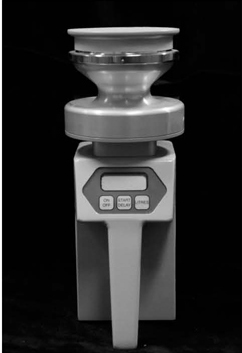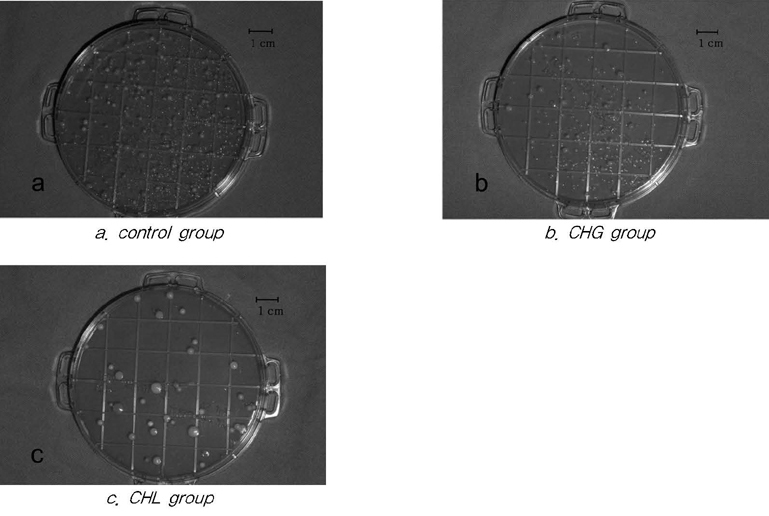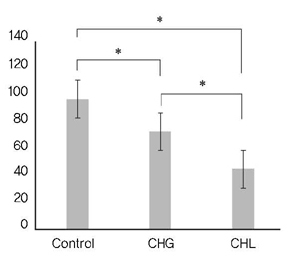J Korean Acad Periodontol.
2009 Sep;39(3):303-310. 10.5051/jkape.2009.39.3.303.
The effect of chlorhexidine on reduction of viable organisms in aerosol produced by ultrasonic scaler
- Affiliations
-
- 1Department of Periodontics, The Institute of Oral Health Science, Samsung Medical Center, Sungkyunkwan University School of Medicine, Seoul, Korea. pkoyang@skku.edu
- KMID: 2212144
- DOI: http://doi.org/10.5051/jkape.2009.39.3.303
Abstract
- PURPOSE
The aerosol generated by ultrasonic scaler can contain bacteria or virus which can penetrate into body through respiratory systems of dentists, dental hygienist or patients. The aim of this study is to evaluate the effect of chlorhexidine digluconate as preoperative mouthrinse or lavage for ultrasonic scaler on the reduction of viable organisms in aerosol produced during periodontal treatment using ultrasonic scaler.
METHODS
30 patients with moderate chronic periodontitis were included and divided into 3 groups: Control (no preoperative mouthrinse and tap water as lavage), CHG (preoperative mouthrinse with 0.1% chlorhexidine digluconate and tap water as lavage), CHL (no reoperative mouthrinse and 0.1% chlorhexidine digluconate as lavage). Each patient received scaling or subgingival curettage for 30 min. In CHG group, mouthrinse with chlorhexidine digluconate was performed for 1 min. before treatment. Before, during and after scaling or subgingival curettage, air sampling was performed for 7 min. each (1000 L/7 min.) with trypticase-soy agar plate. Agar plates were incubated in 37degrees C aerobically. The numbers of colony-forming units (CFU) were counted and compared.
RESULTS
The numbers of CFUs of the samples obtained during treatment were 97+/-14.0 in control, 73.1+/-14.9 in CHG group and 44.5+/-9.0 in CHL group. The difference among the 3 groups was determined to be statistically significant (one-way ANOVA with Bonferroni's correction, p-value: 0.0003). In contrast, the numbers of CFU of samples obtained before and after treatment were not significantly different among the groups.
CONCLUSIONS
Chlorhexidine digluconate used as preoperative mouthrinse or lavage for ultrasonic scaler can reduce the microorganisms in aerosol produced during periodontal treatment using ultrasonic scaler. Less number of microorganisms were detected when chlorhexidine was used as lavage for ultrasonic scaler.
Keyword
MeSH Terms
Figure
Reference
-
1. Badersten A, Nilveus R, Egelberg J. Effect of nonsurgical periodontal therapy. I.Moderately advanced periodontitis. J Clin Periodontol. 1981. 8:57–72.
Article2. Boretti G, Zappa U, Graf H, Case D. Short-term effects of phase I therapy on crevicular cell populations. J Periodontol. 1995. 66:235–240.
Article3. Lee ES, Moon IS, Chai JK, Kim JK. The comparative study of the effectiveness of ultrasonics and curette for the removal of calculus on the root surface. J Korean Acad Periodontol. 1990. 20:153–163.4. Bentley CD, Burkhart NW, Crawford JJ. Evaluating spatter and aerosol contamination during dental procedures. J Am Dent Assoc. 1994. 125:579–584.
Article5. Miller RL, Micik RE. Air pollution and its control in the dental office. Dent Clin North Am. 1978. 22:453–476.6. Legnani P, Checchi L, Pelliccioni GA, D'Achille C. Atmospheric contamination during dental procedures. Quintessence Int. 1994. 25:435–439.7. Micik RE, Miller RL, Mazzarella MA, Ryge G. Studies on dental aerobiology. I. Bacterial aerosols generated during dental procedures. J Dent Res. 1968. 48:49–56.
Article8. Harrel SK, Barnes JB, Rivera-Hidalgo F. Aerosol and splatter contamination from the operative site during ultrasonic scaling. J Am Dent Assoc. 1998. 129:1241–1249.
Article9. Miller RL. Characteristics of blood-containing aerosols generated by common powered dental instruments. Am Ind Hyg Assoc J. 1995. 56:670–676.
Article10. Rosen S, Schmakel D, Schoener M. Incidence of respiratory disease in dental hygienists and dietitians. Clin Prev Dent. 1985. 7:24–25.11. Allsopp J, Basu MK, Browne RM, Burge PS, Matthews JB. Survey of the use of personal protective equipment and prevalence of work related symptoms among dental staff. Occup Environ Med. 1997. 54:125–134.
Article12. Harrel SK, Barnes JB, Rivera-Hidalgo F. Reduction of aerosols produced by ultrasonic scalers. J Periodontol. 1996. 67:28–32.13. Muir KF, Ross PW, MacPhee IT, Holbrook WP, Kowolik MJ. Reduction of microbial contamination from ultrasonic scalers. Br Dent J. 1978. 145:76–78.
Article14. Hugo WB, Longworth AR. Some aspects of the mode of action of chlorhexidine. J Pharm Pharmcol. 1964. 16:655–662.
Article15. Schiott CR, Loe H, Jensen SB, et al. The effect of chlorhexidine mouthrinses on the human oral flora. J Periodontal Res. 1970. 5:84–89.
Article16. Basu MK, Browne RM, Potts AJ, Harrington JM. A survey of aerosol-related symptoms in dental hygienists. J Soc Occup Med. 1988. 38:23–25.
Article17. Suppipat N. Ultrasonics in periodontics. J Clin Periodontol. 1974. 1:206–213.
Article18. Leggat PA, Kedjarune U. Bacterial aerosols in the dental clinic: a review. Int Dent J. 2001. 51:39–44.
Article19. Micik RE, Miller RL, Leong AC. Studies on dental aerobiology: 3. Efficacy of surgical masks in protecting dental personnel from airborne bacterial particles. J Dent Res. 1971. 50:626–630.
Article20. Willeke K, Qian Y, Donnelly J, Grinshpun S, Ulevicius V. Penetration of airborne microorganisms through a surgical mask and a dust/mist respirator. Am Ind Hyg Assoc J. 1996. 57:348–355.
Article21. Williams GH 3rd, Pollok NL 3rd, Shay DE, Barr CE. Laminar air purge of microorganisms in dental aerosols: prophylactic procedures with the ultrasonic scaler. J Dent Res. 1970. 49:1498–1504.
Article22. Trenter SC, Walmsley AD. Ultrasonic dental scaler: associated hazards. J Clin Periodontol. 2003. 30:95–101.
Article23. Riley RL, Knight M, Middlebrook G. Ultraviolet susceptibility of BCG and virulent tubercle bacilli. Am Rev Resp Dis. 1976. 113:413–418.24. Lang NP, Brecx MC. Chlorhexidine digluconate-an agent for chemical plaque control and prevention of gingival inflammation. J Periodont Res. 1986. 21:Suppl 16. 74–89.
Article25. Puig Silla M, Montiel Company JM, Almerich Silla JM. Use of chlorhexidine varnishes in preventing and treating periodontal disease. A review of the literature. Med Oral Patol Oral Cir Bucal. 2008. 13:257–260.26. Kolahi J, Soolari A. Rinsing with chlorhexidine gluconate solution after brushing and flossing teeth: a systematic review of effectiveness. Quintessence Int. 2006. 37:605–612.27. Grossman E, Reiter G, Struzenberger OP, et al. Six-month study on the effects of a chlorhexidine mouthrinse on gingivitis in adults. J Periodont Res. 1986. 21:Suppl 16. 33–43.
Article28. Lee ME, Cho KS, Chai JK, Kim JK. The antimicrobial and clinical effects of a single subgingival irrigation of chlorhexidine and tetracycline solution in periodontal pocket. J Korean Acad Periodontol. 1990. 20:133–152.29. Um HS, Han SB. Effect of subgingival chlorhexidine irrigation on bacteria invaded the periodontitis- affected roots. J Korean Acad Periodontol. 1989. 19:35–45.30. Quirynen M, Avontroodt P, Peeters W, et al. Effect of different chlorhexidine formulations in mouthrinses on de novo plaque formation. J Clin Periodontol. 2001. 28:1127–1136.
Article31. Ciancio S. Expanded and future uses of mouthrinses. J Am Dent Assoc. 1994. 125:29–32.
Article32. Logothetis DD, Martinez-Welles JM. Reducing bacterial aerosol contamination with a chlorhexidine gluconate prerinse. J Am Dent Assoc. 1995. 126:1634–1639.
Article33. Wirthlin MR, Choi JH, Kye SB. Use of chlorine dioxide mouthrinse as the ultrasonic scaling lavage reduces the viable bacteria in the generated aerosols. J West Soc Periodontol Periodontal Abstr. 2006. 54:35–44.
- Full Text Links
- Actions
-
Cited
- CITED
-
- Close
- Share
- Similar articles
-
- Microbial Contaminations of Ultrasonic Scalers, High-Speed Handpieces and Water Syringe Lines
- The effect of working parameters on removal of casting gold alloy using a piezoelectric ultrasonic scaler with scaler tip in vitro
- The Study on the Root Surfaces with SEM and EPMA Following Periodontal Treatment with Curet and Ultrasonic Scaler
- The Effect of a Piezoelectric Ultrasonic Scaler with Curette Tip on Casting Gold Removal in Vitro
- The Effect of a Piezoelectric Ultrasonic Scaler with Curette Tip on Root Substitute Removal in Vitro




